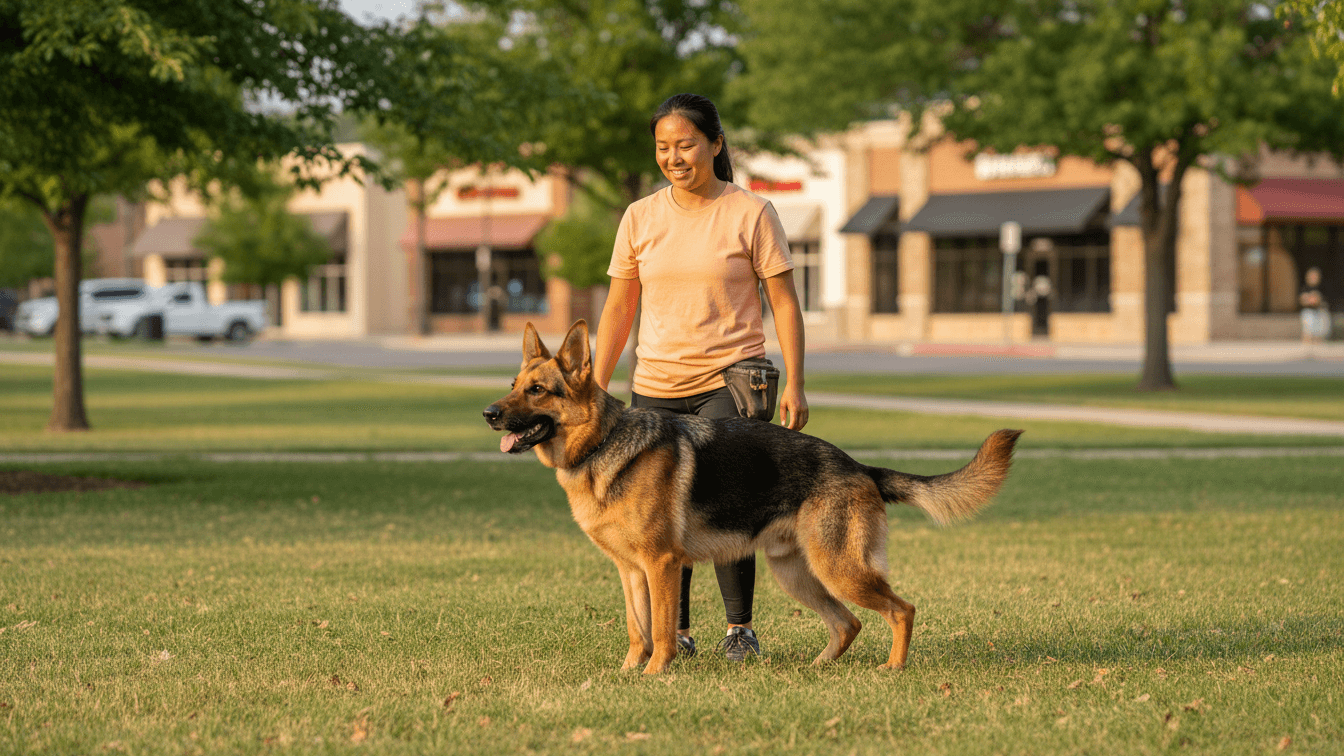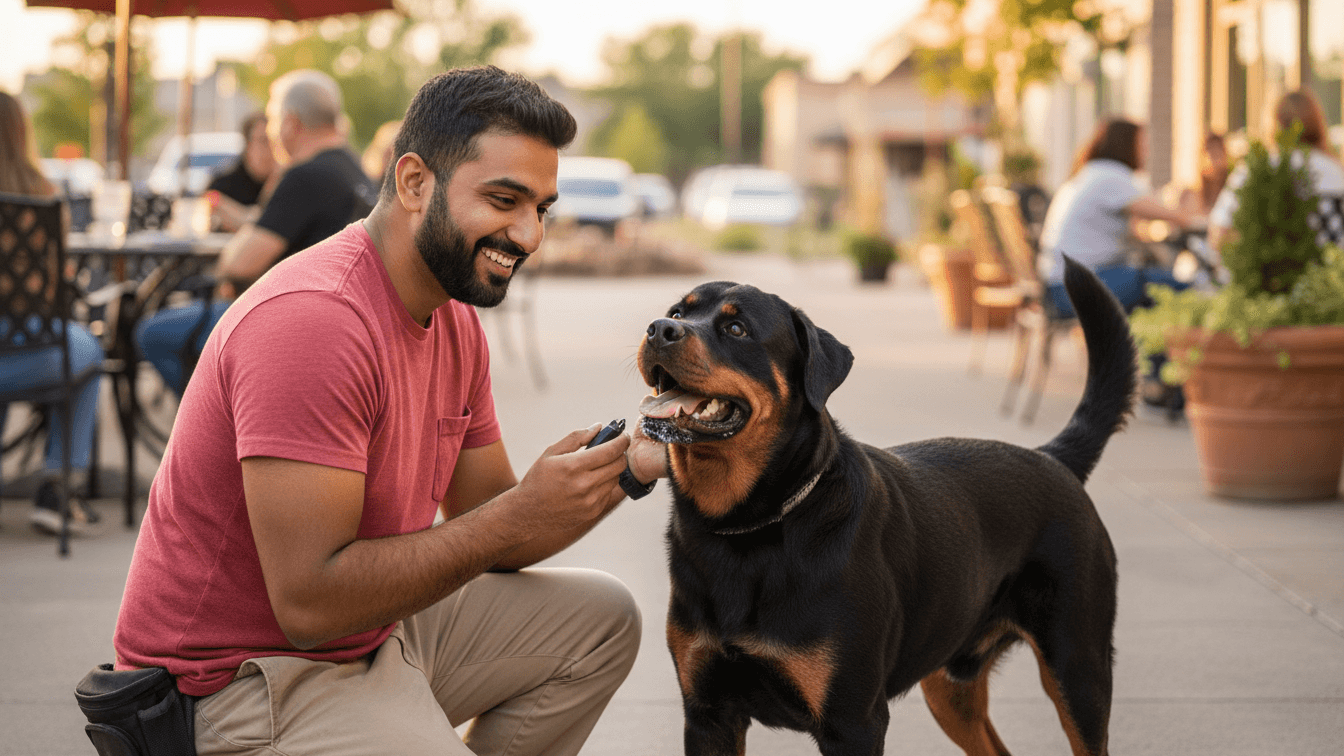Your Complete Guide to Choosing a Dog Trainer in Moore, OK and Surrounding Areas
Living with a dog in Moore means handling everything from walks through Veterans Memorial Park to managing storm-season anxiety. Your dog needs to stay calm during tornado sirens, behave at community rebuilding events, and walk politely past construction zones that seem to pop up regularly around town.
Moore sits in Cleveland County, and your dog training needs often reflect the tight-knit, resilient community that rebuilt itself after the devastating tornadoes. When you find a professional dog trainer who understands these local details, you’ll get better results both at home and out in your everyday life.
How to Choose the Right Trainer
Start by looking for someone who uses positive reinforcement training and can set realistic goals for your Moore lifestyle. This means your dog should learn to walk calmly past busy retail areas along 19th Street, stay focused when emergency sirens test on Saturdays, and handle vet visits without drama.
Credentials give you a quick way to compare trainers’ experience levels. Common dog trainer certifications include KPA-CTP, CPDT-KA, or IAABC-CDBC for behavior problems. If your dog has serious aggression issues or intense reactivity, look for someone with CBCC-KA or a science-based program like CTC.
In-home dog training works great for puppy manners, door greetings, and neighborhood leash skills. Group classes make sense once your dog can focus around other dogs, especially before you try busy spots like the restaurants near the Warren Theatre.
Common Dog Training Methods Explained

Reward-based methods build the trust you want while creating lasting behavior changes. They also help you follow Moore’s rules about keeping dogs under control in public.
Basic obedience covers sit, down, stay, place, recall, and leash training so your dog can handle walks, outdoor patios, and park visits without pulling or jumping on people.
Puppy training focuses on socialization, potty training, bite control, crate comfort, and early leash work. Starting with short, positive training sessions prevents bad habits from forming in the first place.
Behavior modification addresses fear, reactivity, resource guarding, or separation anxiety through careful desensitization and counterconditioning. For serious cases, ask if your trainer works with local veterinarians or can help with storm-related anxiety that many Moore dogs develop.
Private lessons and in-home sessions let you customize everything around your daily routines, while day training can speed up results when you’re short on time.
Dog training classes help your dog practice good manners around other dogs and people. The best classes give dogs plenty of space, screen participants carefully, and teach calm behavior rather than just excitement.
Specialized training like therapy dog training or service dog training requires extra structure, public-access skills, and a very clear step-by-step program.
Stay away from trainers who use fear, intimidation, or pain to get results. Humane methods are safer for everyone, easier to maintain long-term, and much better for keeping peace with your neighbors.
Average Cost of Dog Training in Moore, OK and Surrounding Areas (Updated for 2025)
Prices around Moore and Cleveland County depend on the trainer’s experience, how long sessions last, and where the training happens. Here’s what most local pet owners are paying in 2025.
| Service Type | Average Cost (Moore/Cleveland County) |
|---|---|
| Puppy classes (4-6 weeks) | $140-$260 total |
| Group obedience classes (4-6 weeks) | $150-$280 total |
| Private lessons (60-90 min) | $100-$175 per session |
| In-home coaching packages (4-6 visits) | $400-$850 total |
| Day training (trainer works your dog + handoff) | $425-$900 per week |
| Behavior consult for reactivity/anxiety (initial) | $140-$240 |
| Board and train (2-4 weeks) | $1,900-$4,200 total |
You’ll probably pay extra travel fees for longer distances within Cleveland County or if trainers come from the Oklahoma City metro. Expect higher rates for complex behavior work or storm anxiety programs.
Make sure you understand what’s included, how the trainer tracks progress, and whether they offer a free consultation or free evaluation before you sign up.
Questions to Ask a Potential Dog Trainer
- What training methods do you use, and how do you keep sessions positive and low-stress?
- What credentials do you have, like KPA-CTP or CPDT-KA? Do you keep up with continuing education such as CPDT-KSA?
- How will you customize the training program for my dog’s specific needs and our Moore lifestyle?
- Do you have experience with storm anxiety or weather-related fear issues?
- Do you offer in-home visits, group classes, or day training, and which approach fits my goals best?
- How will we measure my dog’s progress and know when to add more distractions?
- What are the total costs, including any travel fees, and what’s your cancellation policy?
- Do you carry liability insurance, and can you show me proof?
- For behavior problems, will you work with my veterinarian if needed?
- What should I practice between our training sessions to help your dog keep improving?
Local Moore Rules and Considerations
Moore enforces leash laws and nuisance rules to keep parks and neighborhoods safe for everyone. Cleveland County follows Oklahoma’s public health requirements too.
Leashes are required in all public spaces except inside designated dog parks. Keep a standard 6-foot leash with you for city parks and community events.
Oklahoma law requires current rabies vaccination for all dogs over four months old. You can get these through county clinics or your regular vet, and find more details through the Oklahoma State Department of Health.
Excessive barking can be considered a nuisance under Moore city ordinances, so work with your trainer on alert barking and separation anxiety before neighbors start complaining. If your trainer wants to use city parks for commercial sessions, they may need permits and proof of insurance.
Oklahoma doesn’t require special licenses for dog trainers, but if a business boards dogs for payment, the state’s Department of Agriculture oversees kennel licensing and inspections.
Cleveland County Animal Control handles stray animals, licensing information, and other county resources for pet owners.
Local Moore Resources for Dog Owners
These spots give you great places to practice polite manners, work on recalls, and provide safe enrichment for your dog. Always follow the posted rules and etiquette guidelines.
- Bark Park Moore offers a fully fenced off-leash area at Little River Park with separate sections for large and small dogs, perfect for controlled socialization and recall work during quieter times.
- Veterans Memorial Park provides open fields and paved walking paths where you can practice leash manners and focus work around families and joggers.
- Buck Thomas Park includes walking trails and open spaces suitable for distance work and training around distractions like playground noise and sports activities.

FAQs
How much does in-home dog training cost?
Most Moore trainers charge $100-$175 per in-home visit, with discounts available when you buy packages. Behavior problems typically start at the higher end of that range.
Is in-home dog training worth it?
Absolutely, because you’re working on problems exactly where they happen. Your trainer can fix door manners, jumping on guests, counter-surfing, and yard reactivity right at home, then step outside to practice leash skills on your actual neighborhood sidewalks.
Can you pay someone to house train your dog?
Yes, many expert dog trainers offer puppy programs that include potty training, crate routines, and daily schedules. Day training can speed up the process while teaching you how to maintain the progress.
What is the 3-3-3 rule for dog training?
This is a helpful timeline for new or adopted dogs: expect about 3 days for your dog to decompress, 3 weeks to learn your routines, and 3 months to feel completely settled. Good training programs work with this natural adjustment period.
How long will it take to reach my training goals?
Most puppies and friendly adult dogs show solid progress within 4-8 weeks if you practice daily. Fear, reactivity, or aggression typically requires several months of careful behavior modification with gradual increases in difficulty.
What should I bring to group classes?
Pack a flat collar or harness, a 6-foot leash, high-value treats, water, and current vaccination records if your trainer requests them. Leave retractable leashes at home for safety reasons.
What’s the leash law in Moore?
Dogs must be leashed and under control in all public areas, except inside designated off-leash dog parks. Keep that 6-foot leash handy for city parks, greenways, and community events.
Do I need a dog license in Moore or Cleveland County?
Moore and Cleveland County require dog licensing for all dogs over four months old. You can register your dog through Cleveland County Animal Control and must provide proof of current rabies vaccination.
What shots does my dog need in Cleveland County or Oklahoma?
Rabies vaccination is required throughout Oklahoma for all dogs over four months old. Your veterinarian may also recommend distemper-parvo, bordetella, and leptospirosis based on your dog’s lifestyle and exposure risks.
Are dog trainers required to be licensed in Moore or Cleveland County or Oklahoma?
No special trainer licenses exist in Oklahoma. Trainers follow normal business regulations, but if they offer board and train services, their facility may need to be licensed as a boarding kennel under the state’s Department of Agriculture regulations.
Where can I practice off-leash recall?
Use the fenced Bark Park Moore at Little River Park to keep things safe and legal. Try visiting during quieter hours when you’re starting out with training for dogs who are still building confidence.
Which dog parks allow training around Moore?
Bark Park Moore at Little River Park is the primary fenced dog park in the city and allows off-leash play within its designated areas. The separate sections for different dog sizes make it easier to practice specific skills with fewer distractions.
What trails allow dogs for training?
Little River Park and Buck Thomas Park both welcome leashed dogs on their walking trails. These trails are perfect for teaching calm focus around joggers, children, and other dogs while building your dog’s confidence in different environments.
How can I help my dog with storm anxiety?
Many Moore residents face this challenge given the area’s tornado history. Work with a certified dog trainer who understands desensitization protocols and can help create a safe space for your dog during severe weather. Consider adding storm anxiety work to your behavior modification plan early.
Should I avoid aggressive dog training methods?
Yes. Training methods that rely on fear, pain, or intimidation create more problems than they solve. Positive reinforcement training builds a well-behaved dog who listens because they want to, not because they’re afraid. This approach is especially important in a community-focused town like Moore.
The right combination of thoughtful planning, humane methods, and consistent practice around Moore’s parks and neighborhoods will help your dog become a confident, well-behaved companion. If credentials matter to you, don’t hesitate to ask about dog trainer certifications and how your trainer stays current with new techniques. Dog training services in Moore give you access to professionals who understand both the practical challenges of Oklahoma weather and the unique needs of this rebuilding community.